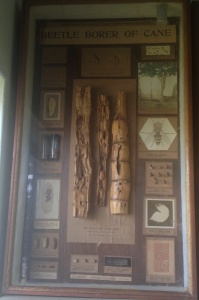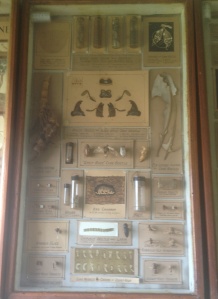Blog Archives
“In the Path of the Storm” – Mackay’s 1918 cyclone
Last month four museums in the Mackay region collaborated on an exhibition to mark the 100th anniversary of the cyclone which struck the region on January 20th 1918. The exhibition was valuable in not only gathering together information and objects to commemorate this devastating event, but also in acting as a timely reminder of our continued vulnerability to severe weather events.
The cyclone, considered a category 4 in today’s system, caused widespread devastation from Mackay and down the coast as far as Yeppoon and Rockhampton. It was responsible for substantial losses in the sugar and beef industries, and claimed 30 lives in Mackay. Mackay Museum, Greenmount Homestead, Pioneer Valley Museum, and Sarina District Historical Centre collaborated with the assistance of Mackay Regional Council and the MDO programme to gather together information, photographs and objects to create “In the Path of the Storm”. By combining in this way to produce the exhibition, the museums were able to present a region wide interpretation of the event and its impacts.
By the very nature of the event the museums were commemorating, objects were going to be hard to come by. But the museums demonstrated what treasure troves community collections can be. Greenmount Homestead contributed a diary kept by Albert Cook at the time of the cyclone as well as an impressive print by Tom Roberts which had been water damaged at the homestead during the cyclone, and which still bore the watermarks. Mackay Museum contributed a model of the brave little Eleanor, the only vessel to survive the cyclone intact and which was crucial in the recovery efforts in the days following the cyclone, when Mackay was completely isolated from the rest of the world. The original vessel is on display at the Mackay Museum. On loan to Mackay Museum from the Queensland Museum collections were the twisted remains of the Brinawarr, a steamship which broke free from its moorings during the cyclone and crashed into the bridge over the Pioneer River, severing communications between north and south Mackay. The remains of the Brinawarr were only rediscovered during the construction of a new bridge in 2009.
The exhibition was held in the Jubilee Community Centre and was the first major exhibition in this new space created from the former library. Community response to the exhibition has been enthusiastic, with many visitors engaging through opportunities to tell their own family’s story of the cyclone. One hundred years on, memories of the event passed down are still painful and vivid.
The exhibition banners have now left the Jubilee Community Centre and begun a tour of the region, first stop Melba House at Marian. So keep a weather eye for the banners coming to a venue near you!
Early science communicators: Edmund Jarvis and Mulgrave Settlers Museum’s new exhibition
Yesterday, Mulgrave Settlers Museum in Gordonvale opened a new exhibition called ‘Beetles, Grubs and other Bugs’. Developed to commemorate the 100th year of sugar research at nearby Meringa Research Station (part of the Bureau of Sugar Experiment Stations) and highlight the importance of cane to the region’s identity, it featured the work of the station’s entomologists as they battled to help cane farmers overcome pests and diseases in the early 20th century.
Central to the exhibition are the display cases created by Edmund Jarvis between 1922 and 1932. A science communicator pioneer, Jarvis created educational cases to help farmers better understand and manage issues affecting their crops. He crafted the displays using specimens, hand drawn diagrams, typed labels and early black and white images and held information days at the station.
You might recall an earlier post from May 2015 outlining details of the cases at the time I was approached by staff at Meringa seeking advice on preservation and storage. Since then I contacted the Mulgrave Settlers Museum about acquiring the cases – there is a strong link between Gordonvale and Meringa, with the first research station being located on Thumm Street just near the present day museum. Thanks to a Regional Arts Development Grant (RADF) from Cairns Regional Council, the cases have also undergone conservation treatment and made ready for this new exhibition. Thanks to conservator Sue Valis at MTQ for her meticulous cleaning and attention to detail.
The RADF grant allowed the museum to purchase a large format scanner to digitise hundreds of images and glass plate negatives that were also part of the donation. These images also feature in the new exhibition, as do a number of other significant artefacts including a lantern used in breeding programs, injectors and sugar refractors (which help to measure sugar content in cane) as well as a microscope belonging to James Buzzacott (on loan from the Australian Industry Sugar Museum in Mourilyan).
Council support also meant that the museum could work with the MDO to create a new exhibition, install a new hanging system, reline cases and rearrange the displays to showcase the research they had undertaken into the cases and the work of Meringa. An exhibition development workshop was held early in the year to set out the parameters. Lead by Travis Teske, the volunteers collaborated with Meringa Station staff and each other to pull the project together. One built timber easels to display the cases, and all hands were on deck for the installation and rearrangement.
The exhibition is open for 6 months. The museum is located near the Mulgrave Mill at 60 Gordon Street, Gordonvale
Edmund Jarvis and his amazing cane beetle displays
It’s not often I get called to look at natural history or entomological collections. And, when I was contacted by staff at Meringa Research Station near Gordonvale to come and assess the condition of some old display cases, I must confess to being a little skeptical. Imagine my surprise, then, when a little bit of research into their creator, Dr Edmund Jarvis, revealed that these cases were going to contain more than your average cane beetle displays.
Dr Jarvis was an entomologist from the early 20th century. He ended his career as the Chief Entomologist to Queensland’s Bureau of Sugar Experiment Station, and specialised in cane beetle research. Prior to this, however, he had a museological career. After moving from Devon, England to Australia, his first job was a Acting Assistant Entomologist, National Museum, Melbourne in 1903 (now, Museum Victoria). In addition to his scientific training, he was well known for his skills in line drawings and water colours.
On site, it was immediately clear that the displays had been arranged by someone with a museological eye. Seven timber framed cases, which date between 1922-1932, had been ‘curated’ to ensure that information is conveyed in an educational manner. They contain a mixture of specimens, line drawings, photographs and labels – all laid out to make the subject matter as accessible as possible. The cases illustrate the research undertaken into pests impacting the sugar industry during the 1920s by the Bureau of Sugar Experiment Stations.
Bureau of Sugar Experiment Stations were, established under The Sugar Experiment Stations Act of 1900 and were initially administered by Queensland’s Department of Agriculture. Employees undertook research to assist growers and millers improve the breeding, planting, growing, harvesting and milling of sugar cane. The focus on the cane beetle, and other cane related pests, demonstrates the importance of the research stations, the work they were conducting, and of the value placed upon the cane industry in Queensland in general.
In valuing these cases, I have come to think of them as more than just the work of a scientist, but as the work of a fellow museum worker with a passion for conveying information to different audiences. I am hoping to secure funds to assist with the conservation of the cases, and a way to interpret them further – in consultation with staff at Meringa.




























